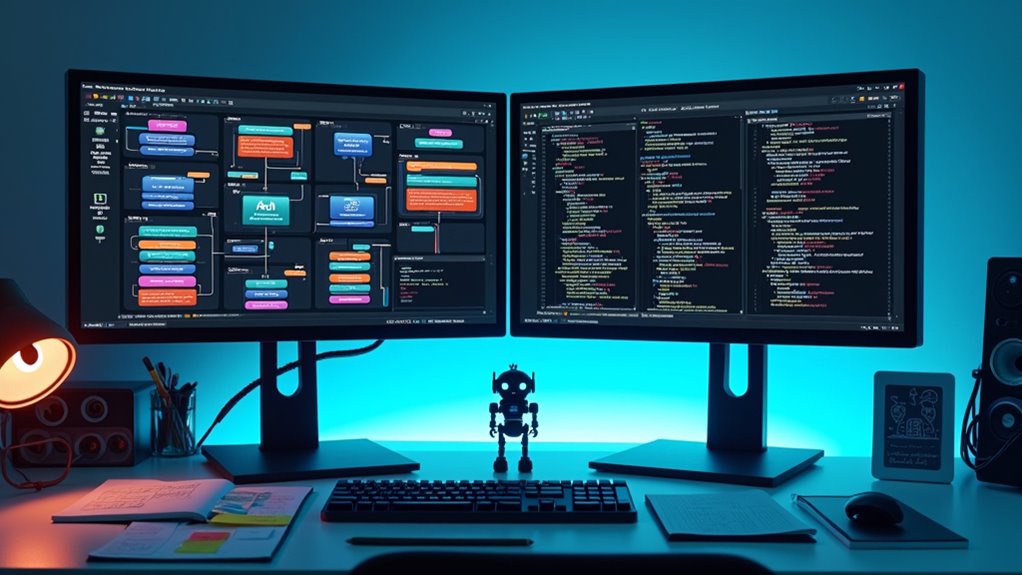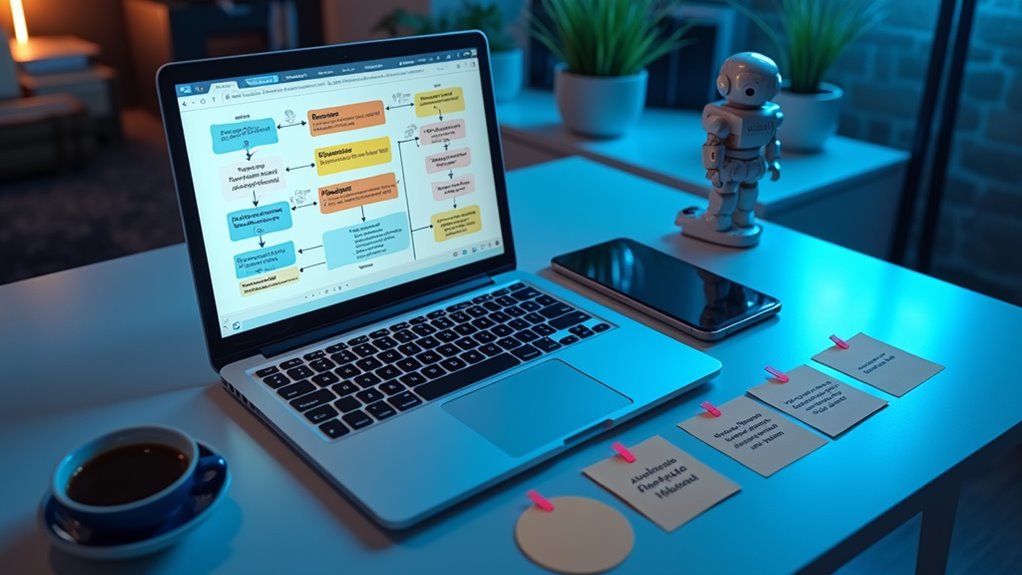Building an AI chatbot requires clear planning before diving into code. Start by defining goals and mapping conversation flows. Choose a framework like Dialogflow or Rasa, then develop your backend with API integrations. Don’t skimp on testing—garbage training data creates garbage responses. Once launched, continuously monitor and improve based on real interactions. The chatbot market’s explosive 23.3% growth rate isn’t accidental—successful bots evolve through rigorous development cycles. The step-by-step process below reveals the full blueprint.

While the concept of talking with machines once belonged firmly in science fiction, AI chatbots have now become an everyday reality that businesses can’t afford to ignore. These computer programs simulate human-like conversations through text or voice, leveraging artificial intelligence to understand language, generate responses, and improve over time. The magic happens through natural language processing (NLP), which breaks down human speech into digestible components through tokenization, parsing, and entity recognition.
Don’t underestimate the power of these digital conversationalists—they’re transforming customer support, data retrieval, and workflow automation across industries.
Building effective chatbots requires careful planning with the right chatbot frameworks and conversational design principles. Start by defining clear goals: What problem are you solving? Who’s your audience? This isn’t just fuzzy planning—it’s the foundation everything else builds upon.
Success with chatbots starts with crystal-clear goals—not fuzzy planning, but the bedrock foundation for everything that follows.
Popular frameworks like Dialogflow, Rasa, and IBM Watson offer robust NLP capabilities that spare you from coding everything from scratch. Your conversational design will make or break user experience, so map out those intents and entities before writing a single line of code!
The development process involves both technical and creative skills. Backend development focuses on APIs and database integration, while the conversation flow requires careful planning through flowcharts. These AI assistants can enhance customer satisfaction by providing effective and prompt responses to inquiries around the clock. The global chatbot market is experiencing tremendous growth with a 23.3% CAGR expected from 2023 to 2030.
Training your chatbot demands quality data—garbage in, garbage out! Machine learning algorithms, from simple Naive Bayes to sophisticated deep learning networks, help your bot recognize patterns and generate appropriate responses. Remember to incorporate dialogue management to maintain context across conversations—nobody likes a chatbot with amnesia.
Testing is non-negotiable. Put your chatbot through rigorous scenarios before activating it on real users. Measure performance metrics like accuracy and response time, but don’t forget the human element—satisfaction surveys reveal insights numbers can’t capture.
The final step? Continuous improvement. AI chatbots aren’t “set it and forget it” tools; they require ongoing maintenance and updates to stay effective. Your digital assistant can only get smarter if you help it learn! These intelligent virtual assistants deliver personalized experiences at scale while simultaneously handling multiple customer inquiries and collecting valuable data for your business.
Frequently Asked Questions
How Much Coding Knowledge Is Required for Chatbot Development?
Chatbot development spans a spectrum of coding requirements.
Beginner requirements are minimal thanks to no-code platforms like ManyChat, where drag-and-drop interfaces and templates handle basic functionality.
However, for custom features or AI integration, more technical knowledge becomes necessary.
Advanced techniques involving NLP, machine learning libraries like TensorFlow, or API development demand significant programming expertise.
The good news? You can start simple and gradually build skills as your chatbot ambitions grow.
What Are the Typical Costs for AI Chatbot Implementation?
Chatbot development expenses vary dramatically based on complexity.
Basic rule-based options run $500-$5,000, while advanced AI versions with NLP capabilities jump to $10,000-$100,000+.
Truly sophisticated generative AI chatbots? Prepare to shell out $200,000+.
Implementation factors like integration requirements, customization needs, and ongoing maintenance all impact final costs.
Off-the-shelf solutions offer budget-friendly alternatives at $50-$500 monthly, perfect for smaller businesses not ready to commit to custom development.
Can AI Chatbots Integrate With Legacy Business Systems?
Yes, AI chatbots can integrate with legacy systems through several approaches. API connections, middleware solutions, and RPA tools enable chatbot compatibility with outdated infrastructure.
Organizations typically use microservices architecture to bridge the gap without complete system overhauls.
Legacy system integration challenges include data format inconsistencies and security concerns, but the payoff is substantial—automation of customer service workflows and access to historical data.
How Often Should Chatbot Training Data Be Updated?
Chatbot training data should be updated monthly for basic systems, but high-traffic bots need weekly refreshes.
Data freshness is vital—stale data equals stale responses, period. User feedback provides the golden insights you’d be foolish to ignore.
Consider updating more frequently when: launching new products, after major industry shifts, or when your error rates creep up.
What Metrics Best Measure AI Chatbot Effectiveness?
Effective AI chatbot performance boils down to a few key metrics.
User satisfaction (CSAT) tells you if people actually like the experience—not just tolerate it.
Response accuracy (Performance Rate) measures whether your bot delivers correct answers or just digital gibberish.
Don’t ignore Goal Completion Rate either; what good is a polite chatbot if it can’t help users accomplish tasks?
Track these alongside metrics like Escalation Rate and NLU Rate for a complete effectiveness picture.








